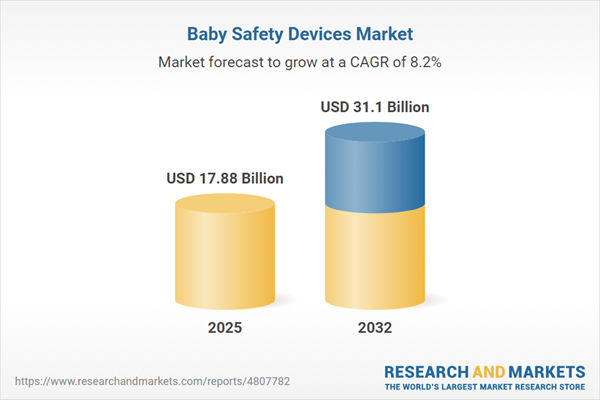Speak directly to the analyst to clarify any post sales queries you may have.
The baby safety devices market is experiencing dynamic growth, driven by rapidly evolving consumer needs, technological advancements, and heightened awareness of regulatory and safety standards. Industry leaders are navigating this complex environment by leveraging innovation, strategic collaborations, and data-driven insights to capture emerging opportunities and overcome supply chain and compliance challenges.
Market Snapshot: Baby Safety Devices Market
The global baby safety devices market grew from USD 16.53 billion in 2024 to USD 17.88 billion in 2025. The market is projected to expand at a CAGR of 8.22%, reaching USD 31.10 billion by 2032. This trajectory reflects the importance placed on child safety by both regulators and consumers, alongside continued innovation in product features and materials.
Scope & Segmentation of the Baby Safety Devices Market
- Product Types: Car seats, booster seats, convertible seats, infant car seats, corner guards, infant monitors (audio monitors, motion sensors, video monitors), and safety gates.
- Age Groups: Infant, newborn, toddler.
- Technologies: Active monitoring systems and passive monitoring systems.
- Applications: Home safety, outdoor safety, travel safety.
- Distribution Channels: Specialty stores, supermarkets, company websites, e-commerce platforms.
- Regions: Americas (including United States, Canada, Mexico, Brazil, Argentina, Chile, Colombia, Peru), Europe, Middle East and Africa (including United Kingdom, Germany, France, Russia, Italy, Spain, Netherlands, Sweden, Poland, Switzerland, United Arab Emirates, Saudi Arabia, Qatar, Turkey, Israel, South Africa, Nigeria, Egypt, Kenya), Asia-Pacific (including China, India, Japan, Australia, South Korea, Indonesia, Thailand, Malaysia, Singapore, Taiwan).
- Leading Companies: AmSafe Inc., Argos Limited, Artsana Group, Baby Cache, Baby Jogger, Baby Trend Inc., Baby's Dream Furniture, BabySecure, Britax Child Safety Inc., CenTrak Inc., Combi Corporation, Cosatto Ltd., Coswell SpA, Dorel Industries Inc., Graco Children's Products Inc., iBaby Labs Inc., Infant Optics, Jané Group, KidCo Inc., Koninklijke Philips N.V., Motorola Mobility LLC, Nuna Intl BV, Panasonic Holdings Corporation, Peg Pérego S.p.A., Regal Lager Inc., Samsung Electronics Co., Ltd.
Key Takeaways for Senior Decision-Makers
- Technological innovation is reshaping the baby safety devices market, with smart solutions now integrating machine learning, IoT connectivity, and advanced sensor capabilities for heightened user oversight.
- Environmental considerations increasingly influence product development, as both consumers and regulators demand sustainable materials and energy-efficient designs across all device categories.
- Shifting consumer preferences are evident across age-based and application-specific segments, highlighting the necessity for companies to develop adaptable product portfolios that address evolving developmental and use-case needs.
- Distribution models are shifting as e-commerce rises, making omnichannel strategies essential for reaching digitally savvy customers and maintaining traditional retail relationships simultaneously.
- Leading brands are expanding their competitive edge through investments in agile production, modular components, and value-added after-sales services—aligning operational efficiency with customer loyalty and trust.
Tariff Impact on the Baby Safety Devices Market
Recent United States tariffs have increased financial pressure on key inputs such as plastics and electronic components, prompting manufacturers to regionalize supply chains and reevaluate procurement. Companies are responding by building resilience into operations, optimizing costs, and streamlining product designs to remain competitive despite shifting trade dynamics.
Research Methodology & Data Sources
This report leverages primary interviews with industry executives and supply chain experts, along with consumer surveys, to capture real-world perspectives and purchase behaviors. Secondary sources include industry publications, regulatory documents, company disclosures, and technical white papers. A rigorous triangulation process and peer review ensure the reliability and validity of all findings.
Why This Report Matters
- Provides actionable intelligence to enable strategic planning in the evolving baby safety devices market.
- Equips business leaders with detailed segmentation, regional insights, and technology trends critical for investment and product development decisions.
- Supports risk mitigation and opportunity capture by analyzing regulatory, supply chain, and competitive factors with a clear focus on future growth drivers.
Conclusion
The baby safety devices market offers compelling opportunities for companies able to innovate and adapt to changing global dynamics. By prioritizing regulatory compliance, sustainable materials, and digital-first distribution, industry participants can secure a strong position in this highly relevant sector.
Additional Product Information:
- Purchase of this report includes 1 year online access with quarterly updates.
- This report can be updated on request. Please contact our Customer Experience team using the Ask a Question widget on our website.
Table of Contents
3. Executive Summary
4. Market Overview
7. Cumulative Impact of Artificial Intelligence 2025
Companies Mentioned
The companies profiled in this Baby Safety Devices market report include:- AmSafe Inc.
- Argos Limited
- Artsana Group
- Baby Cache
- Baby Jogger
- Baby Trend, Inc.
- Baby’s Dream Furniture
- BabySecure
- Britax Child Safety, Inc.
- CenTrak, Inc.
- Combi Corporation
- Cosatto Ltd.
- Coswell SpA
- Dorel Industries Inc.
- Graco Children’s Products Inc.
- iBaby Labs, Inc.
- Infant Optics
- Jané Group
- KidCo, Inc.
- Koninklijke Philips N.V.
- Motorola Mobility LLC
- Nuna Intl BV
- Panasonic Holdings Corporation
- Peg Pérego S.p.A.
- Regal Lager, Inc.
- Samsung Electronics Co., Ltd.
Table Information
| Report Attribute | Details |
|---|---|
| No. of Pages | 193 |
| Published | November 2025 |
| Forecast Period | 2025 - 2032 |
| Estimated Market Value ( USD | $ 17.88 Billion |
| Forecasted Market Value ( USD | $ 31.1 Billion |
| Compound Annual Growth Rate | 8.2% |
| Regions Covered | Global |
| No. of Companies Mentioned | 27 |









